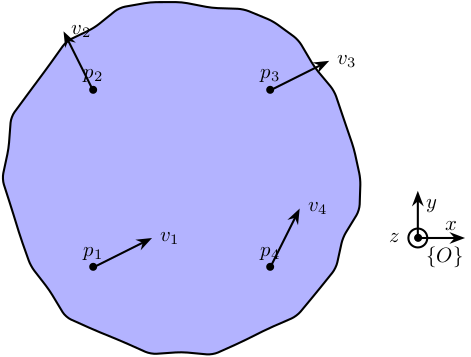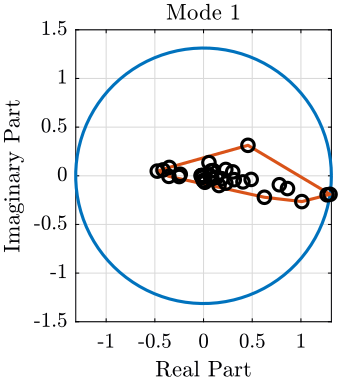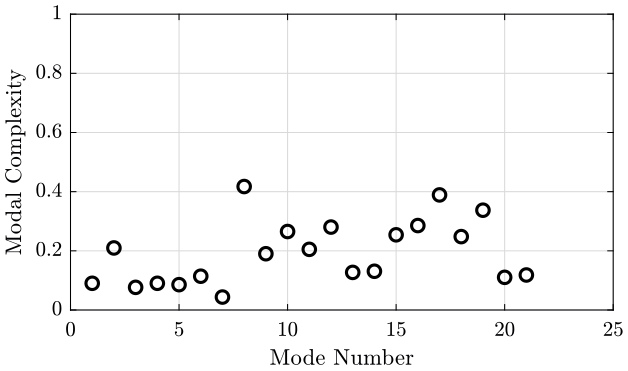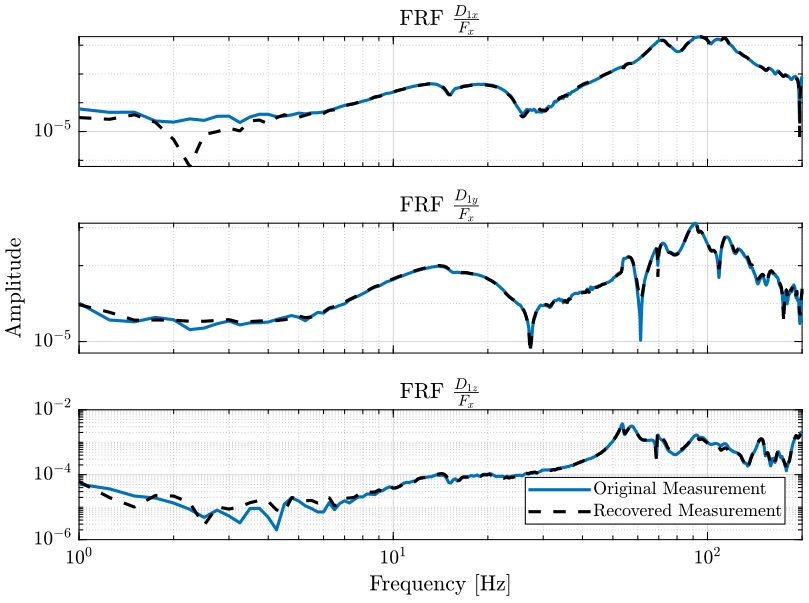Modal Analysis - Modal Parameter Extraction
Table of Contents
- 1. Setup
- 2. Mode extraction and importation
- 3. Positions of the sensors
- 4. Solids
- 5. From local coordinates to global coordinates
- 6. Modal Matrices
- 7. Modal Complexity
- 8. Some notes about constraining the number of degrees of freedom
- 9. TODO Normalization of mode shapes?
- 10. Compare Mode Shapes
- 11. Importation of measured FRF curves
- 12. Importation of measured FRF curves to global FRF matrix
- 13. Analysis of some FRFs
- 14. From local coordinates to global coordinates with the FRFs
- 15. Analysis of some FRF in the global coordinates
- 16. Compare global coordinates to local coordinates
- 17. Verify that we find the original FRF from the FRF in the global coordinates
- 18. TODO Synthesis of FRF curves
1 Setup

Figure 1: Position and orientation of the accelerometer used
2 Mode extraction and importation
First, we split the big modes.asc files into sub text files using bash.
sed '/^\s*[0-9]*[XYZ][+-]:/!d' modal_analysis_updated/modes.asc > mat/mode_shapes.txt sed '/freq/!d' modal_analysis_updated/modes.asc | sed 's/.* = \(.*\)Hz/\1/' > mat/mode_freqs.txt sed '/damp/!d' modal_analysis_updated/modes.asc | sed 's/.* = \(.*\)\%/\1/' > mat/mode_damps.txt sed '/modal A/!d' modal_analysis_updated/modes.asc | sed 's/.* =\s\+\([-0-9.e]\++[0-9]\+\)\([-+0-9.e]\+\)i/\1 \2/' > mat/mode_modal_a.txt sed '/modal B/!d' modal_analysis_updated/modes.asc | sed 's/.* =\s\+\([-0-9.e]\++[0-9]\+\)\([-+0-9.e]\+\)i/\1 \2/' > mat/mode_modal_b.txt
Then we import them on Matlab.
shapes = readtable('mat/mode_shapes.txt', 'ReadVariableNames', false); % [Sign / Real / Imag] freqs = table2array(readtable('mat/mode_freqs.txt', 'ReadVariableNames', false)); % in [Hz] damps = table2array(readtable('mat/mode_damps.txt', 'ReadVariableNames', false)); % in [%] modal_a = table2array(readtable('mat/mode_modal_a.txt', 'ReadVariableNames', false)); % [Real / Imag] modal_a = complex(modal_a(:, 1), modal_a(:, 2)); modal_b = table2array(readtable('mat/mode_modal_b.txt', 'ReadVariableNames', false)); % [Real / Imag] modal_b = complex(modal_b(:, 1), modal_b(:, 2));
We guess the number of modes identified from the length of the imported data.
acc_n = 23; % Number of accelerometers dir_n = 3; % Number of directions dirs = 'XYZ'; mod_n = size(shapes,1)/acc_n/dir_n; % Number of modes
As the mode shapes are split into 3 parts (direction plus sign, real part and imaginary part), we aggregate them into one array of complex numbers.
T_sign = table2array(shapes(:, 1)); T_real = table2array(shapes(:, 2)); T_imag = table2array(shapes(:, 3)); modes = zeros(mod_n, acc_n, dir_n); for mod_i = 1:mod_n for acc_i = 1:acc_n % Get the correct section of the signs T = T_sign(acc_n*dir_n*(mod_i-1)+1:acc_n*dir_n*mod_i); for dir_i = 1:dir_n % Get the line corresponding to the sensor i = find(contains(T, sprintf('%i%s',acc_i, dirs(dir_i))), 1, 'first')+acc_n*dir_n*(mod_i-1); modes(mod_i, acc_i, dir_i) = str2num([T_sign{i}(end-1), '1'])*complex(T_real(i),T_imag(i)); end end end
The obtained mode frequencies and damping are shown below.
data2orgtable([freqs, damps], {}, {'Frequency [Hz]', 'Damping [%]'}, ' %.1f ');
| Frequency [Hz] | Damping [%] |
|---|---|
| 11.4 | 8.7 |
| 18.5 | 11.8 |
| 37.6 | 6.4 |
| 39.4 | 3.6 |
| 54.0 | 0.2 |
| 56.1 | 2.8 |
| 69.7 | 4.6 |
| 71.6 | 0.6 |
| 72.4 | 1.6 |
| 84.9 | 3.6 |
| 90.6 | 0.3 |
| 91.0 | 2.9 |
| 95.8 | 3.3 |
| 105.4 | 3.3 |
| 106.8 | 1.9 |
| 112.6 | 3.0 |
| 116.8 | 2.7 |
| 124.1 | 0.6 |
| 145.4 | 1.6 |
| 150.1 | 2.2 |
| 164.7 | 1.4 |
3 Positions of the sensors
We process the file exported from the modal software containing the positions of the sensors using bash.
cat modal_analysis_updated/id31_nanostation_modified.cfg | grep NODES -A 23 | sed '/\s\+[0-9]\+/!d' | sed 's/\(.*\)\s\+0\s\+.\+/\1/' > mat/acc_pos.txt
We then import that on matlab, and sort them.
acc_pos = readtable('mat/acc_pos.txt', 'ReadVariableNames', false); acc_pos = table2array(acc_pos(:, 1:4)); [~, i] = sort(acc_pos(:, 1)); acc_pos = acc_pos(i, 2:4);
The positions of the sensors relative to the point of interest are shown below.
data2orgtable(1000*acc_pos, {}, {'x [mm]', 'y [mm]', 'z [mm]'}, ' %.0f ');
| x [mm] | y [mm] | z [mm] |
|---|---|---|
| -64 | -64 | -296 |
| -64 | 64 | -296 |
| 64 | 64 | -296 |
| 64 | -64 | -296 |
| -385 | -300 | -417 |
| -420 | 280 | -417 |
| 420 | 280 | -417 |
| 380 | -300 | -417 |
| -475 | -414 | -427 |
| -465 | 407 | -427 |
| 475 | 424 | -427 |
| 475 | -419 | -427 |
| -320 | -446 | -786 |
| -480 | 534 | -786 |
| 450 | 534 | -786 |
| 295 | -481 | -786 |
| -730 | -526 | -951 |
| -735 | 814 | -951 |
| 875 | 799 | -951 |
| 865 | -506 | -951 |
| -155 | -90 | -594 |
| 0 | 180 | -594 |
| 155 | -90 | -594 |
4 Solids
We consider the following solid bodies:
- Bottom Granite
- Top Granite
- Translation Stage
- Tilt Stage
- Spindle
- Hexapod
We create a structure solids that contains the accelerometer number of each solid bodies (as shown on figure 1).
solids = {}; solids.granite_bot = [17, 18, 19, 20]; solids.granite_top = [13, 14, 15, 16]; solids.ty = [9, 10, 11, 12]; solids.ry = [5, 6, 7, 8]; solids.rz = [21, 22, 23]; solids.hexa = [1, 2, 3, 4]; solid_names = fields(solids);
5 From local coordinates to global coordinates

From the figure above, we can write:
\begin{align*} \vec{v}_1 &= \vec{v} + \Omega \vec{p}_1\\ \vec{v}_2 &= \vec{v} + \Omega \vec{p}_2\\ \vec{v}_3 &= \vec{v} + \Omega \vec{p}_3\\ \vec{v}_4 &= \vec{v} + \Omega \vec{p}_4 \end{align*}With
\begin{equation} \Omega = \begin{bmatrix} 0 & -\Omega_z & \Omega_y \\ \Omega_z & 0 & -\Omega_x \\ -\Omega_y & \Omega_x & 0 \end{bmatrix} \end{equation}\(\vec{v}\) and \(\Omega\) represent to velocity and rotation of the solid expressed in the frame \(\{O\}\).
We can rearrange the equations in a matrix form:
\begin{equation} \left[\begin{array}{ccc|ccc} 1 & 0 & 0 & 0 & p_{1z} & -p_{1y} \\ 0 & 1 & 0 & -p_{1z} & 0 & p_{1x} \\ 0 & 0 & 1 & p_{1y} & -p_{1x} & 0 \\ \hline & \vdots & & & \vdots & \\ \hline 1 & 0 & 0 & 0 & p_{4z} & -p_{4y} \\ 0 & 1 & 0 & -p_{4z} & 0 & p_{4x} \\ 0 & 0 & 1 & p_{4y} & -p_{4x} & 0 \end{array}\right] \begin{bmatrix} v_x \\ v_y \\ v_z \\ \hline \Omega_x \\ \Omega_y \\ \Omega_z \end{bmatrix} = \begin{bmatrix} v_{1x} \\ v_{1y} \\ v_{1z} \\\hline \vdots \\\hline v_{4x} \\ v_{4y} \\ v_{4z} \end{bmatrix} \end{equation}and then we obtain the velocity and rotation of the solid in the wanted frame \(\{O\}\):
\begin{equation} \begin{bmatrix} v_x \\ v_y \\ v_z \\ \hline \Omega_x \\ \Omega_y \\ \Omega_z \end{bmatrix} = \left[\begin{array}{ccc|ccc} 1 & 0 & 0 & 0 & p_{1z} & -p_{1y} \\ 0 & 1 & 0 & -p_{1z} & 0 & p_{1x} \\ 0 & 0 & 1 & p_{1y} & -p_{1x} & 0 \\ \hline & \vdots & & & \vdots & \\ \hline 1 & 0 & 0 & 0 & p_{4z} & -p_{4y} \\ 0 & 1 & 0 & -p_{4z} & 0 & p_{4x} \\ 0 & 0 & 1 & p_{4y} & -p_{4x} & 0 \end{array}\right]^{-1} \begin{bmatrix} v_{1x} \\ v_{1y} \\ v_{1z} \\\hline \vdots \\\hline v_{4x} \\ v_{4y} \\ v_{4z} \end{bmatrix} \end{equation}This inversion is equivalent to a mean square problem.
mode_shapes_O = zeros(mod_n, length(solid_names), 6); for mod_i = 1:mod_n for solid_i = 1:length(solid_names) solids_i = solids.(solid_names{solid_i}); Y = reshape(squeeze(modes(mod_i, solids_i, :))', [], 1); A = zeros(3*length(solids_i), 6); for i = 1:length(solids_i) A(3*(i-1)+1:3*i, 1:3) = eye(3); A(3*(i-1)+1:3*i, 4:6) = [0 acc_pos(i, 3) -acc_pos(i, 2) ; -acc_pos(i, 3) 0 acc_pos(i, 1) ; acc_pos(i, 2) -acc_pos(i, 1) 0]; end mode_shapes_O(mod_i, solid_i, :) = A\Y; end end
6 Modal Matrices
We want to obtain the two following matrices: \[ \Omega = \begin{bmatrix} \omega_1^2 & & 0 \\ & \ddots & \\ 0 & & \omega_n^2 \end{bmatrix}; \quad \Psi = \begin{bmatrix} & & \\ \{\psi_1\} & \dots & \{\psi_n\} \\ & & \end{bmatrix} \]
[ ]How to add damping to the eigen value matrix?
eigen_value_M = diag(freqs*2*pi); eigen_vector_M = reshape(mode_shapes_O, [mod_n, 6*length(solid_names)])';
\[ \{\psi_1\} = \begin{Bmatrix} \psi_{1_x} & \psi_{2_x} & \dots & \psi_{6_x} & \psi_{1_x} & \dots & \psi_{1\Omega_x} & \dots & \psi_{6\Omega_z} \end{Bmatrix}^T \]
7 Modal Complexity
A method of displaying modal complexity is by plotting the elements of the eigenvector on an Argand diagram, such as the ones shown in figure 3.
To evaluate the complexity of the modes, we plot a polygon around the extremities of the individual vectors. The obtained area of this polygon is then compared with the area of the circle which is based on the length of the largest vector element. The resulting ratio is used as an indication of the complexity of the mode.
A little complex mode is shown on figure 3 whereas an highly complex mode is shown on figure 4. The complexity of all the modes are compared on figure 5.

Figure 3: Modal Complexity of one mode with small complexity

Figure 4: Modal Complexity of one higly complex mode

Figure 5: Modal complexity for each mode
8 Some notes about constraining the number of degrees of freedom
We want to have the two eigen matrices.
They should have the same size \(n \times n\) where \(n\) is the number of modes as well as the number of degrees of freedom. Thus, if we consider 21 modes, we should restrict our system to have only 21 DOFs.
Actually, we are measured 6 DOFs of 6 solids, thus we have 36 DOFs.
From the mode shapes animations, it seems that in the frequency range of interest, the two marbles can be considered as one solid. We thus have 5 solids and 30 DOFs.
In order to determine which DOF can be neglected, two solutions seems possible:
- compare the mode shapes
- compare the FRFs
The question is: in which base (frame) should be express the modes shapes and FRFs? Is it meaningful to compare mode shapes as they give no information about the amplitudes of vibration?
| Stage | Motion DOFs | Parasitic DOF | Total DOF | Description of DOF |
|---|---|---|---|---|
| Granite | 0 | 3 | 3 | |
| Ty | 1 | 2 | 3 | Ty, Rz |
| Ry | 1 | 2 | 3 | Ry, |
| Rz | 1 | 2 | 3 | Rz, Rx, Ry |
| Hexapod | 6 | 0 | 6 | Txyz, Rxyz |
| 9 | 9 | 18 |
9 TODO Normalization of mode shapes?
We normalize each column of the eigen vector matrix. Then, each eigenvector as a norm of 1.
eigen_vector_M = eigen_vector_M./vecnorm(eigen_vector_M);
10 Compare Mode Shapes
Let's say we want to see for the first mode which DOFs can be neglected. In order to do so, we should estimate the motion of each stage in particular directions. If we look at the z motion for instance, we will find that we cannot neglect that motion (because of the tilt causing z motion).
mode_i = 3; dof_i = 6; mode = eigen_vector_M(dof_i:6:end, mode_i); figure; hold on; for i=1:length(mode) plot([0, real(mode(i))], [0, imag(mode(i))], '-', 'DisplayName', solid_names{i}); end hold off; legend();
figure; subplot(2, 1, 1); hold on; for i=1:length(mode) plot(1, norm(mode(i)), 'o'); end hold off; ylabel('Amplitude'); subplot(2, 1, 2); hold on; for i=1:length(mode) plot(1, 180/pi*angle(mode(i)), 'o', 'DisplayName', solid_names{i}); end hold off; ylim([-180, 180]); yticks([-180:90:180]); ylabel('Phase [deg]'); legend();
test = mode_shapes_O(10, 1, :)/norm(squeeze(mode_shapes_O(10, 1, :))); test = mode_shapes_O(10, 2, :)/norm(squeeze(mode_shapes_O(10, 2, :)));
11 Importation of measured FRF curves
There are 24 measurements files corresponding to 24 series of impacts:
- 3 directions, 8 sets of 3 accelerometers
For each measurement file, the FRF and coherence between the impact and the 9 accelerations measured.
In reality: 4 sets of 10 things
a = load('./modal_analysis/frf_coh/Measurement1.mat');
figure; ax1 = subplot(2, 1, 1); hold on; plot(a.FFT1_AvXSpc_2_1_RMS_X_Val, a.FFT1_AvXSpc_2_1_RMS_Y_Mod) hold off; set(gca, 'XScale', 'log'); set(gca, 'YScale', 'log'); set(gca, 'XTickLabel',[]); ylabel('Amplitude'); title(sprintf('From %s, to %s', FFT1_AvXSpc_2_1_RfName, FFT1_AvXSpc_2_1_RpName)) ax2 = subplot(2, 1, 2); hold on; plot(a.FFT1_AvXSpc_2_1_RMS_X_Val, a.FFT1_AvXSpc_2_1_RMS_Y_Phas) hold off; ylim([-180, 180]); yticks(-180:90:180); xlabel('Frequency [Hz]'); ylabel('Phase [deg]'); set(gca, 'xscale', 'log'); linkaxes([ax1,ax2],'x'); xlim([1, 200]);
12 Importation of measured FRF curves to global FRF matrix
FRF matrix \(n \times p\):
- \(n\) is the number of measurements: \(3 \times 24\)
- \(p\) is the number of excitation inputs: 3
23 measurements: 3 accelerometers
\begin{equation} \text{FRF}(\omega_i) = \begin{bmatrix} \frac{D_{1_x}}{F_x}(\omega_i) & \frac{D_{1_x}}{F_y}(\omega_i) & \frac{D_{1_x}}{F_z}(\omega_i) \\ \frac{D_{1_y}}{F_x}(\omega_i) & \frac{D_{1_y}}{F_y}(\omega_i) & \frac{D_{1_y}}{F_z}(\omega_i) \\ \frac{D_{1_z}}{F_x}(\omega_i) & \frac{D_{1_z}}{F_y}(\omega_i) & \frac{D_{1_z}}{F_z}(\omega_i) \\ \frac{D_{2_x}}{F_x}(\omega_i) & \frac{D_{2_x}}{F_y}(\omega_i) & \frac{D_{2_x}}{F_z}(\omega_i) \\ \vdots & \vdots & \vdots \\ \frac{D_{23_z}}{F_x}(\omega_i) & \frac{D_{23_z}}{F_y}(\omega_i) & \frac{D_{23_z}}{F_z}(\omega_i) \\ \end{bmatrix} \end{equation}n_meas = 24; n_acc = 23; dirs = 'XYZ'; % Number of Accelerometer * DOF for each acccelerometer / Number of excitation / frequency points FRFs = zeros(3*n_acc, 3, 801); COHs = zeros(3*n_acc, 3, 801); % Loop through measurements for i = 1:n_meas % Load the measurement file meas = load(sprintf('./modal_analysis/frf_coh/Measurement%i.mat', i)); % First: determine what is the exitation (direction and sign) exc_dir = meas.FFT1_AvXSpc_2_1_RMS_RfName(end); exc_sign = meas.FFT1_AvXSpc_2_1_RMS_RfName(end-1); % Determine what is the correct excitation sign exc_factor = str2num([exc_sign, '1']); if exc_dir ~= 'Z' exc_factor = exc_factor*(-1); end % Then: loop through the nine measurements and store them at the correct location for j = 2:10 % Determine what is the accelerometer and direction [indices_acc_i] = strfind(meas.(sprintf('FFT1_H1_%i_1_RpName', j)), '.'); acc_i = str2num(meas.(sprintf('FFT1_H1_%i_1_RpName', j))(indices_acc_i(1)+1:indices_acc_i(2)-1)); meas_dir = meas.(sprintf('FFT1_H1_%i_1_RpName', j))(end); meas_sign = meas.(sprintf('FFT1_H1_%i_1_RpName', j))(end-1); % Determine what is the correct measurement sign meas_factor = str2num([meas_sign, '1']); if meas_dir ~= 'Z' meas_factor = meas_factor*(-1); end % FRFs(acc_i+n_acc*(find(dirs==meas_dir)-1), find(dirs==exc_dir), :) = exc_factor*meas_factor*meas.(sprintf('FFT1_H1_%i_1_Y_ReIm', j)); % COHs(acc_i+n_acc*(find(dirs==meas_dir)-1), find(dirs==exc_dir), :) = meas.(sprintf('FFT1_Coh_%i_1_RMS_Y_Val', j)); FRFs(find(dirs==meas_dir)+3*(acc_i-1), find(dirs==exc_dir), :) = exc_factor*meas_factor*meas.(sprintf('FFT1_H1_%i_1_Y_ReIm', j)); COHs(find(dirs==meas_dir)+3*(acc_i-1), find(dirs==exc_dir), :) = meas.(sprintf('FFT1_Coh_%i_1_RMS_Y_Val', j)); end end freqs = meas.FFT1_Coh_10_1_RMS_X_Val;
13 Analysis of some FRFs
acc_i = 3; acc_dir = 1; exc_dir = 1; figure; ax1 = subplot(2, 1, 1); hold on; plot(freqs, abs(squeeze(FRFs(acc_dir+3*(acc_i-1), exc_dir, :)))); hold off; set(gca, 'XScale', 'log'); set(gca, 'YScale', 'log'); set(gca, 'XTickLabel',[]); ylabel('Amplitude'); ax2 = subplot(2, 1, 2); hold on; plot(freqs, mod(180+180/pi*phase(squeeze(FRFs(acc_dir+3*(acc_i-1), exc_dir, :))), 360)-180); hold off; ylim([-180, 180]); yticks(-180:90:180); xlabel('Frequency [Hz]'); ylabel('Phase [deg]'); set(gca, 'xscale', 'log'); linkaxes([ax1,ax2],'x'); xlim([1, 200]);
figure; hold on; for i = 1:3*n_acc plot(freqs, squeeze(COHs(i, 1, :)), 'color', [0, 0, 0, 0.2]); end hold off; xlabel('Frequency [Hz]'); ylabel('Coherence [\%]');
Composite Response Function.
We here sum the norm instead of the complex numbers.
HHx = squeeze(sum(abs(FRFs(:, 1, :)))); HHy = squeeze(sum(abs(FRFs(:, 2, :)))); HHz = squeeze(sum(abs(FRFs(:, 3, :)))); HH = squeeze(sum([HHx, HHy, HHz], 2));
exc_dir = 3; figure; hold on; for i = 1:3*n_acc plot(freqs, abs(squeeze(FRFs(i, exc_dir, :))), 'color', [0, 0, 0, 0.2]); end plot(freqs, abs(HHx)); plot(freqs, abs(HHy)); plot(freqs, abs(HHz)); plot(freqs, abs(HH), 'k'); hold off; set(gca, 'XScale', 'lin'); set(gca, 'YScale', 'lin'); xlabel('Frequency [Hz]'); ylabel('Amplitude'); xlim([1, 200]);
14 From local coordinates to global coordinates with the FRFs
% Number of Solids * DOF for each solid / Number of excitation / frequency points FRFs_O = zeros(length(solid_names)*6, 3, 801); for exc_dir = 1:3 for solid_i = 1:length(solid_names) solids_i = solids.(solid_names{solid_i}); A = zeros(3*length(solids_i), 6); for i = 1:length(solids_i) A(3*(i-1)+1:3*i, 1:3) = eye(3); A(3*(i-1)+1:3*i, 4:6) = [0 acc_pos(i, 3) -acc_pos(i, 2) ; -acc_pos(i, 3) 0 acc_pos(i, 1) ; acc_pos(i, 2) -acc_pos(i, 1) 0]; end for i = 1:801 FRFs_O((solid_i-1)*6+1:solid_i*6, exc_dir, i) = A\FRFs((solids_i(1)-1)*3+1:solids_i(end)*3, exc_dir, i); end end end
15 Analysis of some FRF in the global coordinates
solid_i = 6; dir_i = 1; exc_dir = 1; figure; ax1 = subplot(2, 1, 1); hold on; plot(freqs, abs(squeeze(FRFs_O((solid_i-1)*6+dir_i, exc_dir, :)))); hold off; set(gca, 'XScale', 'log'); set(gca, 'YScale', 'log'); set(gca, 'XTickLabel',[]); ylabel('Amplitude'); ax2 = subplot(2, 1, 2); hold on; plot(freqs, mod(180+180/pi*phase(squeeze(FRFs_O((solid_i-1)*6+dir_i, exc_dir, :))), 360)-180); hold off; ylim([-180, 180]); yticks(-180:90:180); xlabel('Frequency [Hz]'); ylabel('Phase [deg]'); set(gca, 'xscale', 'log'); linkaxes([ax1,ax2],'x'); xlim([1, 200]);
16 Compare global coordinates to local coordinates
solid_i = 1; acc_dir_O = 6; acc_dir = 3; exc_dir = 3; figure; ax1 = subplot(2, 1, 1); hold on; for i = solids.(solid_names{solid_i}) plot(freqs, abs(squeeze(FRFs(acc_dir+3*(i-1), exc_dir, :)))); end plot(freqs, abs(squeeze(FRFs_O((solid_i-1)*6+acc_dir_O, exc_dir, :))), '-k'); hold off; set(gca, 'XScale', 'log'); set(gca, 'YScale', 'log'); set(gca, 'XTickLabel',[]); ylabel('Amplitude'); ax2 = subplot(2, 1, 2); hold on; for i = solids.(solid_names{solid_i}) plot(freqs, mod(180+180/pi*phase(squeeze(FRFs(acc_dir+3*(i-1), exc_dir, :))), 360)-180); end plot(freqs, mod(180+180/pi*phase(squeeze(FRFs_O((solid_i-1)*6+acc_dir_O, exc_dir, :))), 360)-180, '-k'); hold off; ylim([-180, 180]); yticks(-180:90:180); xlabel('Frequency [Hz]'); ylabel('Phase [deg]'); set(gca, 'xscale', 'log'); linkaxes([ax1,ax2],'x'); xlim([1, 200]);
17 Verify that we find the original FRF from the FRF in the global coordinates
From the computed FRF of the Hexapod in its 6 DOFs, compute the FRF of the accelerometer 1 fixed to the Hexapod during the measurement.
FRF_test = zeros(801, 3); for i = 1:801 FRF_test(i, :) = FRFs_O(31:33, 1, i) + cross(FRFs_O(34:36, 1, i), acc_pos(1, :)'); end

Figure 6: Comparison of the original measured FRFs with the recovered FRF from the FRF in the common cartesian frame
The reduction of the number of degrees of freedom from 69 (23 accelerometers with each 3DOF) to 36 (6 solid bodies with 6 DOF) seems to work well.